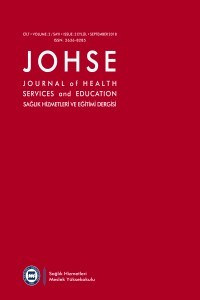Ebelik Öğrencilerinin Bilgisayarlı Simülasyon Uygulaması Sonrası Görüşlerinin Değerlendirilmesi
Amaç: Bu çalışma, ebelik öğrencilerinin bilgisayarlı simülatörkullanımı sonrası görüşlerinin belirlenmesi amacıyla yapılmıştır.Yöntem: Bu araştırma nitel bir çalışma olup veriler yarıyapılandırılmış görüşme tekniğiyle yazılı olarak elde edilmiştir.Araştırmaya Orta Karadeniz Bölgesinde bir Devlet ÜniversitesininSağlık Yüksekokulu Ebelik bölümü son sınıf öğrencisi olan 35 kişikatılmıştır. Öğrenciler rastgele 8-9 kişilik 4 gruba ayrılmışlardır.Her bir grupla 3 gün boyunca bir buçuk saat bilgisayarlı simülatörleçeşitli senaryolar üzerinde çalışılmıştır. Veriler betimsel analiz vebetimsel-yorumlayıcı analiz yöntemiyle değerlendirilmiştir.Bulgular: Öğrenciler bilgisayarlı simülatör uygulamasını “faydalı,gerçekçi, yol gösterici, eğlenceli, güzel, kalıcı, zevkli, öğretici,geliştirici, verimli, gerekli, deneyim sağlayıcı, öz güven artırıcı,olağanüstü, heyecanlı, etkili bir eğitim, korkuları azaltan, farklı birduygu ve büyük bir şans” olarak değerlendirmişlerdir.Sonuç: Bilgisayarlı simülasyon uygulamalarının, öğrencileringerçeğe en yakın durumları değerlendirebilmelerini ve kriz anınıyönetmelerini sağlaması nedeniyle önemli olduğu düşünülmektedir.Bu bağlamda bilgisayarlı simülasyon uygulamalarını ebelikeğitiminde ve uygulamalarında daha yaygın hale getirilmesigerekmektedir.
Anahtar Kelimeler:
Eğitim, Eğitim aktiviteleri, Ebelik
Evaluation of Midwifery Students’ Opinions after Computerized Simulation Practice
Objective: This study was conducted to determine the opinions ofmidwifery students after computerized simulator use.Methods: This study was a qualitative study and the data wereobtained in written form using semi-structured interview technique.A total of 35 midwifery students from a State University in theMiddle Black Sea Region participated in the study. Students wererandomly divided into 4 groups of 8-9 people. Various scenarioswere studied with computerized simulator for one and a halfhours for 3 days with each group. The data were evaluated withdescriptive analysis and descriptive-interpretive analysis.Results: Students evaluated the computer simulator practiceas “helpful, realistic, guiding, entertaining, beautiful, lasting,enjoyable, instructive, developer, productive, necessary experience,self-confidence building, extraordinary, exciting, decreasing fear,effective training, a different feeling and a great chance”.Conclusions: It’s thought that computerized simulation practicesare important. In this context, computerized simulation practicesshould be made more widespread in midwifery education andpractice.
Keywords:
Education, Education activities, Midwife,
___
- 1. Gaba DM. The future vision of simulation in health care. Qual Saf Health Care. 2010; 13:2–10. doi: 10.1136/qshc.2004.009878
- 2. Aggarwal R, Mytton TO, Derbrew M, Hananel D, Heydenburg M, Issenberg B, MacAulay C, Mancini ME, Morimoto T, Soper N, Ziv A, Reznick R. Training and simulation for patient safety. Qual Saf Health Care. 2010; 19:34-43. doi:10.1136/qshc.2009.038562
- 3. Lathrop A, Winningham B, VandeVusse L. Simulation-based learning for midwives: background and pilot ımplementation. Journal of Midwifery & Women’s Health. 2007; 52(5):492-498 doi:10.1016/j.jmwh.2007.03.018
- 4. Alinier G, A typology of educationally focused medical simulation tools. Medical Teacher. 2007; 29: 243–250 DOI: 10.1080/014.215.90701551185
- 5. Ennen CS, Satin AJ. Training and assessment in obstetrics: role of simülation. Best Practise and Research Clinical Obstetrics and Gynaecology.2010; 24: 747-758
- 6. Catling C, Hogan R, Fox D, Cummins A, Kelly M, Sheehan A. Simulation workshops with first year midwifery students. Nurse Education in Praticem. 2016; 17:109-115
- 7. Deegan M, Terry L. Student midwives’ perceptions of real – time simulation: a qualitive phenomenological study. British Journal of Midwifery. 2013; 21(7) :590-598
- 8. Durmaz A, Elem E, Unutkan A, Keskin N. Simülasyonun normal doğum becerilerine ve öz-yeterlilik düzeylerine etkisi. Journal of Current Researches on Health Sector. 2017;7(2):41-52 doi: 10.26579/jocrehes_7.2.4
- 9. Reyhan F, Mete A, Sayıner FD, Çelik N. Ebelik bölümü öğrencilerinin simülasyon eğitimine bakışları. 1. Uluslararası Doğu Akdeniz Ebelik Kongresi Kongre Kitapçığı; 226-227, Adana, 2017
- 10. Rall M, Gaba DM, Dieckmann P, Eich C. Patient simulation. In Miller’s Anesthesia .(Editor Miller RD) Churchill Livingstone, 2009; 179-181
- 11. Söylemez V, Alacapınar FG. Örneklendirilmiş Bilimsel Araştırma Yöntemleri.(3th ed). Ankara: Anı.2011
- 12. Cooper S, Cant R, Porter J, Bogossian F, Mckenna L, Brady S, Fox – Young S. Simulation based learning in midwifery education : A systematic review. Women and Birth. 2012; 25(2): 64–78
- 13. Coffey F. Learning by simulation – is it a useful tool for midwifery education?. New Zealand College of Midwives Journal. 2015; 51:30-36
- 14. Terzioğlu F, Kapucu S, Özdemir L, Boztepe H, Duygulu S, Tuna Z, Akdemir N. Simülasyon yönetimine ilişkin hemşirelik öğrencilerinin görüşleri, Sağlık Bilimleri Fakültesi Hemşirelik Dergisi. 2012;16-23
- 15. Kaddoura M. New graduate nurses’ perceptions of the effects of clinical simülation on their critical thinking, learning and confidence. Journal of Continuing Education in Nursing. 2010; 41(11):506-16
- 16. Eker F, Açıkgöz F, Karaca A. Hemşirelik Öğrencileri Gözüyle Mesleki Beceri Eğitimi. Dokuz Eylül Üniversitesi Hemşirelik Yüksekokulu Elektronik Dergisi. 2014; 7 (4)
- 17. Bambini D, Washburn J, Perkins R. Outcomes of clinical simulation for novice nursing students: Communication, confidence, clinical judgment. Nursing Education Perspectives. 2009; 30(2):79-82
- 18. Okuda Y, Bryson EO, DeMaria S, Jacobson L, Quinones J, Shen B, Levine IA. The utility of simulation in medical education: what is the evidence?. Mount Sinai Journal of Medicine: A Journal of Translational and Personalized Medicine.2009;76(4): 330-343
- Başlangıç: 2017
- Yayıncı: Marmara Üniversitesi
Sayıdaki Diğer Makaleler
Sağlık Hizmetleri Meslek Yüksekokulu Öğrencilerinin Uygulamalı Derslere İlişkin Görüşleri
Nitel Araştırma Yöntemlerinden İz Sürme (Tracer) ve Kan Transfüzyonu Sürecinde Bir Uygulama Örneği
Ebelik Öğrencilerinin Bilgisayarlı Simülasyon Uygulaması Sonrası Görüşlerinin Değerlendirilmesi
Duygu MURAT ÖZTÜRK, Fatma Deniz SAYINER, Neşe ÇELİK
Kromatografiye Giriş, Yüksek Performanslı Sıvı Kromatografi Kullanımında Basit İpuçları
Burcu ESER, Aylin SEPICI DINÇEL
